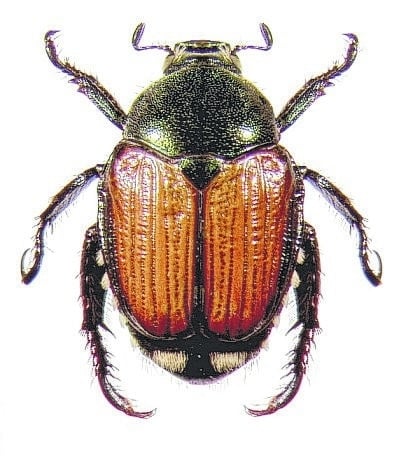

Japanese beetles usually start arriving about mid-June. They are a metallic copper-green color and slightly larger than a pencil eraser. Fact sheet “Japanese Beetle” (http://ohioline.osu.edu/factsheet/ENT-46) has all the details.
Watch for the first beetles to appear. Acting as scouts, they produce a congregation pheremome (scent) that attracts others, so hand-picking and drowning these first arrivals in soapy water may lessen the numbers. I cut part of the top off a gallon milk jug, add a couple inches of water and some dish soap, and then just brush the beetles into the water. They don’t swim well at all! Be sure to empty out the container, as the dead beetles will create an unpleasant aroma as they decompose.
Traps may do more harm than good.
The traps you see in gardening supply displays may be somewhat useful for monitoring, but they are not especially effective for control. In fact, they may attract more beetles to the area where they are placed, and these beetles may stop to feed first. Unfortunately, Japanese beetles have good taste; among their favorite plants are roses, Japanese and Norway maples, crabapples, and plum and cherry trees. Actually they feed on about 400 different plants. If you use traps, set them as far away from the plants you wish to protect as possible.
Several chemicals, including acephate (Orthene), carbaryl (Sevin), and a number of pyrethroids are labeled for control of adult beetles. If feeding is heavy, repeat applications every five to ten days may be needed. Be sure to follow the label instructions and avoid spraying blooming flowers, as some of these chemicals are highly toxic to bees.
If Japanese beetles are a recurring problem in your landscape, you may want to take steps to reduce their numbers in the future. Part of these and most other beetles’ life cycles is spent as grubs in the soil. The grubs feed on the roots of grass and can be almost as destructive as the adult beetles. Controlling these larvae may help for the future. Milky spore bacterial disease has not proven very effective in Ohio; and parasitic nematodes have been only marginally effective. Several chemicals can be effective if applied typically in June through August. To be effective they must reach the root zone of the lawn by being watered in with at least one-half inch of water. These chemicals are not cheap, so if beetle and grub damage has not been a problem in the past, you may wish to wait and see if a problem develops later this year.
Another tactic is to try using plants that do not attract Japanese beetles. Some common plants in this category include most of the evergreen trees, flowering dogwood, red and white oak, red and silver maple, lilac, lilies, hydrangea, coreopsis, poppies, pansies, and a several others mentioned in the “Japanese beetle” fact sheet mentioned above.
For more information about Japanese beetles and other gardening situations, visit our “hotline” at the OSU Extension office, 810 Fair Road, Sidney, or you can call 498-7239 and speak with a master gardener volunteer from 10 until 1 each Monday or Thursday now through September. Visit us on select dates at the Downtown Sidney Farmer’s Market.



